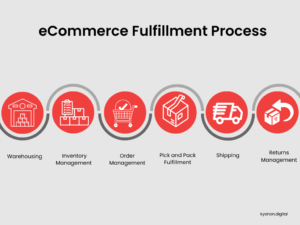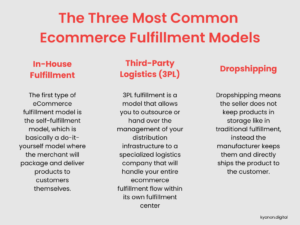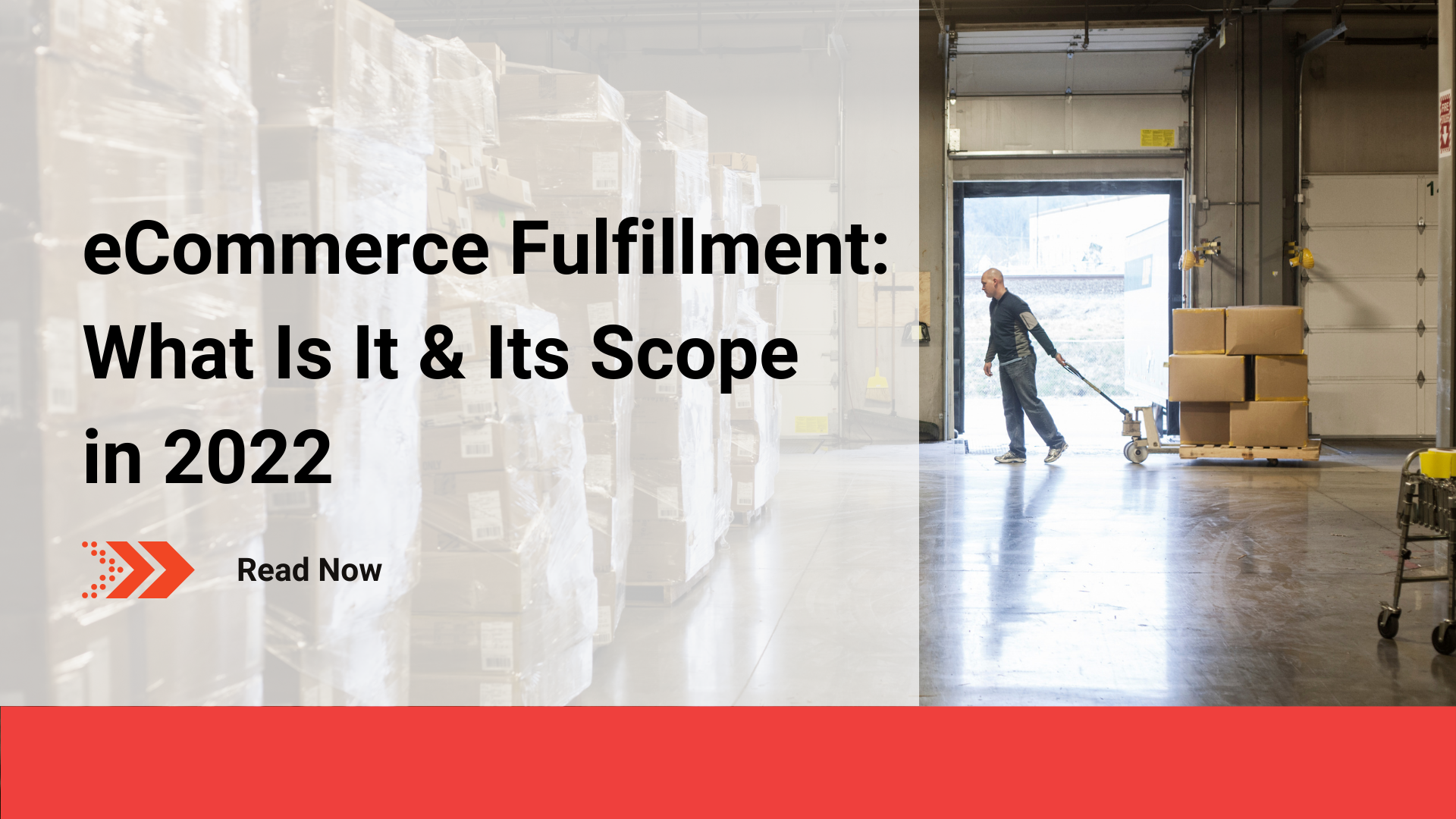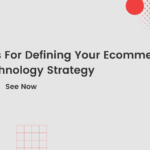It is possible that eCommerce fulfillment services make an outstanding contribution to firms’ success, as it is the one that covers all processes after a customer places an order on a website or app. To satisfy customer’s requirements and ensure their comeback to your store, it is necessary to streamline and optimize your fulfillment chain so that your business’s online and offline elements are in synchronization for better delivering service and sales.
1. eCommerce Fulfillment definition
eCommerce fulfillment is the process involving the operations post receiving the order, which means getting an order delivered to a customer after they order it online. This part of the supply chain includes operations like storage, inventory management, order management, packing, shipping, returns, post order tracking, etc.
It can be said that even before you understood the concept of fulfillment, it has always been an integral part of your business from the beginning.
2. eCommerce Fulfillment Process

2.1 Warehousing

Warehousing is the first aspect of order fulfillment that stores inventory in an organized fashion for better accessibility. Specifically, according to Shipbob, it is known as the process of storing physical goods or inventory in a warehouse or storage facility before they are sold or distributed, and most of them are very high-volume and fast paced places with product being moved constantly.
Warehouses safely and securely store items is the key factor influencing locating the products easily and quickly, and maintaining a track of your inventory in a better convenient manner.
2.2 Inventory Management
The next crucial operation included in eCommerce fulfillment is inventory management, which is the monitoring of an ecommerce business’s stocked goods including storing inventory, ordering and restocking inventory, and inventory forecasting to assess customer demands and forecast in advance for your business.
Not only does correctly managing inventory imply proactively reordering the right inventory quantity for stockouts and backorders prevention, but also, it can be a source of leverage for ecommerce companies looking to increase efficiency and reduce operational costs. Rachel Andrea Go explained that with the right configuration, it will allow businesses to better manage their cash flow, predict and plan for sales velocity, and ensure a seamless buyer experience.
2.3 Order Management

Order management is the broad concept of overseeing all purchases that are received on your eCommerce website. This step includes receiving, keeping track of, and fulfilling customer orders across sales channels. It is necessary for order management to be in complete sync with the warehousing and inventory management system, so that the information is updated on all fronts, and the further processing steps can be undertaken almost immediately.
You can reap the benefits of order management to automate and streamline the mundane process of order receiving, tracking, and fulfillment. It also helps you track both overstocking and understocking, so that you are safeguarded and able to manage your seasonal sales based on customer purchase history.
2.4 Pick and Pack Fulfillment

The picking and packing process will be proceeded after an order is received in the eCommerce fulfillment. It refers to using a picking list to retrieve items from storage as soon as an order is placed online, and packing is the act of putting all ordered stuff in a box or poly mailer together with any necessary packing materials. Picking and packaging require complete accuracy and precision so that no inaccurate order is packed and delivered to the customer.
Pick and pack is more cost-efficient and offers faster turnaround times than traditional order fulfillment strategies, which is a contributing factor in making it a popular option for eCommerce retailers. Furthermore, with a proper process of pick and pack fulfillment, it can bring about an increase in customer satisfaction since items are kept in good condition and orders are shipped on time.
2.5 Shipping

In the fulfillment process, the most essential part is considered shipping. Ecommerce shipping encompasses receiving and processing orders, picking and packing the purchased product at a warehouse, printing shipping labels, and even managing returns.
Offering your customers the right shipping rates and options is crucial to long-term success, not to mention providing the right shipping options at the right times can help reduce cart abandonment and increase revenue.
There are three shipping considerations that ecommerce business should beware: shipping costs calculation. packing options, and shipment tracking.
2.6 Returns Management
Returns in ecommerce fulfillment involves receiving, assessing, and processing returned items back into the available stock. ITS Logistics showed that 92 percent of customers state they will buy something from an online store again if returns are easy, which demonstrates how ecommerce returns policy plays a vital role in customer experience improvement, and the importance of ease of return to eCommerce shoppers as it can be a key factor influencing drive your sales.
Besides, by having optimized returns management, it can lead to better profit margins by reducing transportation spend, to reselling items that would have been a complete loss if disposed of upon return. Furthermore, by offering options to your customers who wish to return items that make it easier for them, it can go a long way to boost customer satisfaction. Lastly, returns management can help you identify ways to reuse, resell or recycle materials.
3. The Three Most Common Ecommerce Fulfillment Models

3.1 In-House Fulfillment
The first type of eCommerce fulfillment model is the self-fulfillment model, which is basically a do-it-yourself model where the merchant will package and deliver products to customers themselves. With this model, the merchant is solely responsible for all aspects of fulfillment. Even though it is suitable for small-scale businesses with minimal volume, it is not sustainable. Eventually, when your orders increase, you will have to invest in additional storage space and resources to manage your operations.
- Pros: This model eliminates the cost of outsourcing fulfillment, which can include paying for storage fees, peak season charges, and other associated costs. In-house fulfillment allows businesses that are highly specialized or have limited daily orders or cash flow to use their funds for personnel, product iteration, and quality packing materials.
- Cons: As order volume grows, in-house fulfillment can take a lot of time and resources away from other aspects of the business. The oversight and experience of industry professionals when seeking the most optimized packing materials may not be available in in-house fulfillment, or getting high-volume shipping discounts.
3.2 Third-Party Logistics (3PL)
3PL fulfillment is a model that allows you to outsource or hand over the management of your distribution infrastructure to a specialized logistics company that will handle your entire ecommerce fulfillment flow within its own fulfillment center.
- Pros: 3PL companies work with several merchants; they have a training resource for all functions and fulfillment centers to facilitate faster processing orders. It gives you the advantage of shipping a more considerable amount of orders and also gives you a chance to scale your business depending upon the demand. If you find an experienced 3PL they will help you get into new sales channels.
- Cons: A third-party ecommerce fulfillment company controls your ecommerce businesses’ final handoff of value to your customers, so you will give up a lot of the control that comes with packing and distributing products yourself.
3.3 Dropshipping
Dropshipping means the seller does not keep products in storage like in traditional fulfillment, instead the manufacturer keeps them and directly ships the product to the customer. So, when a customer places an order from your store, it is manually or automatically transported and sent to the supplier from where it is processed and delivered.
Drop shipping allows you to sell products with less investment at the beginning. The trade-off for this reduced risk is less control over the fulfillment process. In addition, your profits on each sale will be lower.
- Pros: Dropshipping allows you to sell products with less investment at the beginning, it helps you test out the viability of new markets for existing products, and find your way around storage and processing.
- Cons: Dropshipping does not allow you to control inventory and reduces any scope for branding. Customization of the product and quality control could be lacking, which might have an adverse effect on the order fulfillment in most cases.
4. Scope of eCommerce Fulfillment in 2022
4.1 Automation

Significant increase in automation trends is expected in 2022 as technology becomes more involved in the entire fulfillment chain. Software that makes it possible to track and monitor the products will be the norm in the industry in the future. Furthermore, using warehouse management systems in conjunction with inventory management systems can help with centralized management and social communication among warehouses and fulfillment centers.
According to Shiprocket, Amazon fulfillment centers are already using robots to help improve their operations. They have significantly reduced shipping times, improved the inventory process and they assisted workers in many ways.
4.2 Data-Backed Platforms
The use of technologies such as big data will help bridge the gap between marketplaces, courier partners, payment gateways, consumers, and the other stakeholders in the eCommerce supply chain. Real-time data will place importance on demand forecasting, shipping, return management, and many other areas. Even now, the pressure on merchants is intense to reduce delivery times. As a result, sellers will be able to make more informed decisions and process orders faster with the application of real-time data management.
4.3 Omnichannel fulfillment

Sellers are now venturing into sales on different platforms such as mobile applications, eCommerce websites, social media, etc. With an omnichannel retail experience, sellers will now adopt the omnichannel fulfillment method of doing business where they can integrate their retail store information into a centralized network and disseminate information accordingly, with an omnichannel retail experience.
eCommerce fulfillment plays a vital role in your eCommerce business, and it is important to do it properly if you want to achieve a good delivery experience for your customers. Kyanon Digital hopes this article will provide useful information, and help you have a correct view of eCommerce fulfillment to make rational decisions related to this aspect.


